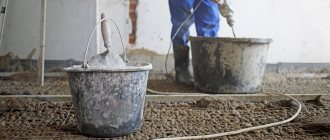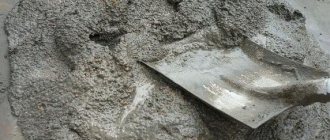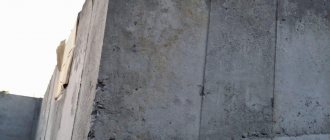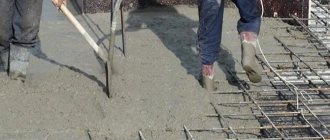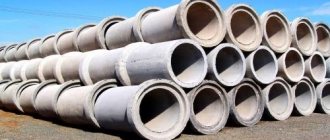I’m not a big fan of semi-finished products, but I can say with confidence: by purchasing concrete mix in bags, you actually save time and save yourself from the need to store bulk building materials in the yard in front of the house. Depending on the purpose, here you can select the dry mixture by brand. For example, for screeding under tiles, M-150 is enough, but for making fence posts you will need M-300 or M-400. Of course, if the need for concrete is calculated in tens or even hundreds of cubic meters, then this option is unprofitable, but for small construction this is exactly what you will be satisfied with.
Composition and properties
Dry concrete mixtures are a ready-made semi-finished product with all the required components except water. Most often, the list of components of such concrete is as follows:
- Portland cements of increased strength from M 400 and beyond.
- Clean sand.
- Sealant granules no larger than 2 cm.
- Various additives: limestone powders, plasticizers, sealants, substances that reduce the ability of concrete to absorb moisture - water repellents.
All components are carefully prepared, dried, which prevents clumping during storage, and are contained in a certain proportion.
All dry concrete has a good level of strength, adhesion and resistance to destruction and deformation. In addition, they are vapor permeable, which helps to minimize the accumulation of condensation and the increase in humidity indoors. And also such concretes can easily withstand fairly low temperatures, this allows them to be used in any climate zone without compromising the quality of construction.
Dry concrete can be used for concreting foundations, areas with constant loads, as well as pouring floors or using it for other suitable purposes - grouting seams, plastering walls, and so on.
The density of the dry mixture is on average 1600 kg/m3, the finished solution is approximately 2180 kg/m3. The average amount of water for preparing concrete is 110-120 g per 1 kg of dry material.
Examples of manufacturers
The modern market offers a wide range of construction sandstones from domestic manufacturers, such as Besto, Rusean, Finstroy, Gran-Service, Stone Flower, VZZHBI and many others. All of them are packaged in bags, tubs and other convenient containers. The most popular products are: Rusean m 400, m 300, LUIX.
Return to contents
Rusean m 400
To prepare the high-strength mixture M400, Portland cement of inorganic origin, filler with a fraction of 0.15-20 mm, and chemicals to improve properties are used.
Features of M400: high adhesion, resistance to mechanical damage, resistance to cracks, moisture and low temperatures. These characteristics determine the wide range of applications of Rusean for creating high-strength and wear-resistant surfaces, for example, floors in industrial premises and foundations.
Return to contents
M300
This brand is prepared from high-quality cement and purified river sand with a wide fractional composition from 0 to 2.5 mm. To improve performance, special mineral additives are used. Packaged in bags. M300 is a universal non-shrinking mixture. Distinctive properties: reliability, ease of use, good ductility and adhesion. After drying, the surface does not crack, which allows you to obtain high-quality coatings.
Composition M300 is intended for installation work on different surfaces. With its help, floors are poured and leveled, high-strength screeds are made, concrete walls and foundations are erected and repaired. Application for arranging foundations and pouring is also possible.
Return to contents
LUIX
LUIX sand concrete is characterized by fine grain, which allows you to obtain durable and high-quality coatings that are resistant to external factors. This brand is suitable for decorative work. High strength ensures the use of sand concrete as masonry masses. Distinctive properties: high vapor permeability, adhesion and resistance to low temperatures.
Return to contents
Other products
Other equally popular products are the SILTEK and Dolmat brands. Superplastic concrete from POLIMIN and dry mixes Kreps are also well known. Packaging occurs in bags.
Return to contents
Types of additives
Depending on the composition and the additives included in it, the set of characteristics varies, as well as the price of the finished mixture. Common types of additives are presented in the table:
| Color pigment | Added to give the mixture the required shade. This additive is used in concrete intended for finishing work both indoors and outdoors. |
| Antifreeze additive | Strengthens the viscosity of concrete at low temperatures. |
| Epoxy component | Increases the coefficients of hardness, water resistance and ductility. |
| Water repellents | They allow the manufacture of reservoirs for swimming pools, home ponds, as well as laying underground foundations in areas with high humidity, where groundwater comes relatively close to the surface of the earth. |
| Various plasticizers | Serve to thin the mixture without adding more liquid in order to simplify the use of the solution. |
| Additives to change the rate of hardening | Inclusions that slow down and accelerate the setting process of concrete. |
The advantage over a highly specialized focus is, of course, the versatility of the mixture. This material is in great demand among buyers.
What to consider when calculating
To calculate how many bags of cement are in a cube of concrete, you need to take into account the following parameters:
- design strength of concrete;
- brand of cement;
- packaging size;
- aggregate fraction;
- proportion of components.
The composition for preparing the concrete mixture is regulated by Building Codes and Rules 5.01.23-83. The document indicates the recommended grades of Portland cement to obtain a monolith with the required characteristics.
For individual construction, concrete is used:
- M100 - for installing cushions under foundations,
- M150 - pouring paths, blind areas, floor screeds, bases for sheds, garages, gazebos, installing curbs, fence posts;
- M200 - production of monolithic foundations, lintels, floor slabs, columns and walls.
In accordance with the brand of the monolith, the consumption of the binder is normalized.
Cement brand
The main characteristic that needs to be taken into account when purchasing is the brand of cement. It determines the strength characteristics of the binder component. The higher it is, the less consumption of this material.
In individual construction, the most used are PC grades 350-500.
Areas of application of Portland cement:
- M200, M300 - finishing work;
- M400, M500 - monolithic foundations, walls and other building structures.
You need to pay attention to freshness - strength decreases with long-term storage. According to GOST rules, the shelf life of PC is 1 year from the date of manufacture.
Important! The rule that is used when purchasing a binder is that its grade should be one and a half to two times higher than the corresponding characteristics of the concrete mixture. For concrete M100 you need to take cement M200, etc.
Fillers
Cement consumption per cubic meter of concrete depends on the size of coarse aggregate - crushed stone, gravel and fine aggregate - sand. The standards provide for the use of increasing and decreasing coefficients when fraction sizes deviate upward or downward.
If the size of the crushed stone is less than 20 mm, the amount of binder is increased by 10%, otherwise it is reduced by 5-10%.
The sand fineness modulus is taken into account:
- if it does not exceed 1.5, the PC consumption is increased by 12%;
- up to 2 - by 5%.
Concrete fillers
In order to add lightness and reduce weight, porous aggregates are added to dry concrete mixtures, which are divided into the following types according to their origin:
- Natural.
- Artificial.
- By-products of industrial production.
Natural fillers include the following materials:
- Pumice is a porous, sponge-like rock composed of acidic volcanic glass.
- Carbonate rocks - include shell rocks, calcareous tuffs, porous limestones, etc.
- Natural slag is a rock of volcanic origin; it has large pores in the form of shells of varying depths located over the entire surface.
- Tuff - unlike volcanic slag, has a finely porous structure, includes ash and volcanic glass.
Artificial fillers are vermiculite, expanded clay, perlite, agloporite, and various slags. Industrial waste includes ash and fuel slag.
All of these fillers are capable of imparting different characteristics to the finished concrete product. But if you need to not only lighten, but also qualitatively insulate the structure, then polystyrene is used - this material has the form of foam granules, its thermal insulation properties are so high that it is added to the solution not only for floor screed, but also when constructing walls, and this allows reduce their thickness.
In most cases, all these fillers have to be purchased separately and added to the concrete mixture when mixing independently.
Preparation of the solution
Mixing does not necessarily require the use of special equipment - for example, manual and electric concrete mixers. Depending on the required amount of solution, you can get by with hand tools like a shovel and a basin or tank.
Usually the packaging indicates how much water is required to dilute the mixture. But different needs require different consistency and density of the solution. In addition, the ratio of components is different:
- To create concrete blocks you will need a mixture of cement, sand and water in a ratio of 2:8:1. Since the mixture is already ready, most often they simply take 10 times less water, for example, 40 kg of dry concrete will require 20 liters of water. To fill the floor screed, the same solution is suitable. To lay a brick wall, in addition to the main ingredients, you will need to include a plasticizer.
- Preparing facade plaster for applying the first layer will require a mixture with a high sand content - 2:10:1, the second layer will require the addition of a plasticizer and a slightly different combination of the main components - 4:10:1. The final layer of cement mortar should contain 1 part cement, 8 parts sand and 1 part water, as well as plasticizing powder.
- To grout joints on a brick or stone wall, use the traditional ratio of 2:4:1 with the addition of a plasticizer.
To enhance the strength of concrete, a reinforcing component can be added to it in the form of a welded mesh or individual steel rods. Reinforced concrete is used for the manufacture of beams, floors and load-bearing walls, as well as other construction projects with increased constant load.
Dry concrete mixture is produced in packaging bags of 30, 40, 50 kg or more. For large-scale construction, you can buy huge packages weighing from 1 ton.
Manual mixing
If you don’t need too much solution for the job, it can be easily mixed by hand:
- Dry concrete M400 in bags is poured onto a clean, dry floor or into a special tub.
- The amount of water required according to the instructions is poured into the recess on top.
- Slowly, carefully turn the mixture with a shovel until a homogeneous solution is obtained. If you do this too harshly, dry concrete will generate dust, and inhalation of tiny cement particles will certainly affect your health in the form of a dry, obsessive cough or more serious lung problems in case of prolonged and regular exposure.
It is necessary to mix thoroughly so that no inclusions of the dry mixture remain.
Using a concrete mixer
During global construction, mechanical devices are used to speed up the mixing process and reduce labor costs. In addition, the use of a concrete mixer will ensure uniform mixing and, as a result, good uniformity of the solution. And if there is insufficient mixing with water, the quality characteristics of concrete, and then products made from it, will deteriorate, which will affect the strength and safety of the entire building.
When using an electric concrete mixer, you must follow basic safety rules when working with electrical appliances.
Unlike manual work, the required amount of water is first poured into the concrete mixer tank, and only then dry concrete is poured from bags in the required proportion. In the hot season, cold water is used - this allows the mixture to remain in a liquid state longer, and in winter, before mixing, the water must be heated to 35-40 degrees.
Rules for working with a concrete mixer:
- Before starting work, you must install the equipment on a flat surface.
- Do not turn on the machine with ingredients loaded into it. First, start the drum at idle speed, then gradually pour water into it and add dry concrete mixture.
- The mixing process should not last more than 10 minutes, as the solution will begin to dry out.
Ready-mixed concrete should be used immediately after mixing and should not be left for more than two hours. The solution finally hardens only after 20-30 days - it is after this time that it exhibits all the characteristics stated in the description. However, the mixture can be refilled as soon as the previous layer acquires sufficient hardness, which can be easily determined by pressing - if the surface does not deform, then work can continue. The hardening time depends on the thickness of the layer, as well as density and composition, so it is impossible to indicate unambiguous terms.
What is dry concrete in bags?
Dry concrete is a completely ready-to-use mixture of components (cement, sand, crushed stone) packaged in bags weighing 30-40 kg. In this case, the preparation and dosage of components is carried out in the factory using special equipment. This guarantees perfect proportions, perfect mixing, as well as perfect “dryness” of all components.
The buyer of dry concrete can only unload the required amount into a concrete mixer, container or onto a sheet of iron, add water, mix and immediately begin pouring the structure.
Prices for dry concrete
The finished mixture is sold in bags in construction stores. If the packaging exceeds 1 ton, then such packaging can be purchased at construction bases. In addition, it is possible to order goods of any denomination via the Internet.
The price of dry concrete mix in bags differs depending on the density, place of sale and additives included in the composition. Regarding density, concrete is divided into the following types:
- M100 and M150 are lightweight concrete, the numbers mean that its resistance to compression is in this case 100 kg per cubic centimeter. Used as a base for a poured foundation. The price on the market fluctuates between 2.5 - 2.8 thousand rubles. for 1 cubic meter of dry material. When ordering an additional antifreeze additive, the price increases slightly.
- M200, M250 - the cost of a cubic meter of mixture is from 2.8 to 3.2 thousand rubles. This type is used for pouring foundations, making floor slabs, walls, screeds, blocks and flooring.
- M300 and M350 - used to create road surfaces, manufacture monolithic structures and load-bearing walls. A cubic meter of concrete of this brand costs approximately 3.2–3.4 thousand rubles.
- M400, M450 - cost on the market from 3.5 to 4 thousand rubles per 1 m³. These are the most common types of concrete mix, as they are considered universal. They can be used both for small construction work and for the construction of hydraulic structures.
- M500-M550 are the densest varieties, used for complex structures - dams, subways, bridges and other strategic objects. The price per cube of each of these brands exceeds 4.5 thousand rubles.
In addition to the wholesale cost per 1 cubic meter, buyers are often interested in prices for smaller packaging, for example, in bags of 40-50 kg. This volume will cost approximately from 100 to 230 rubles per bag; exact prices depend on the supplier and brand of concrete.
Advantages of purchasing ready-mixed dry concrete
- Saving construction site space - there is no need to allocate space for a pile of sand and a pile of crushed stone;
- Saving time and labor costs for preparing concrete;
- One hundred percent compliance of the finished material with the declared brand;
- The ability to plan construction processes over time - dry concrete can be used in small batches, while the ordered concrete mixer needs to be processed within a few hours.
Retail chains offer developers dry concrete in bags from various manufacturers, for various purposes. Domestic products have proven themselves well.
The company produces and sells several types of dry concrete (expanded clay concrete, sand concrete, dry concrete and dry concrete “LUIX”), packaged in bags weighing 30 and 40 kg, to perform various tasks, the average market cost of a bag of dry concrete weighing 40 kg is 140-160 rubles
Benefits of mixtures
In contrast to independently mixing all the components of a concrete solution - cement, sand, fillers and various additives, the use of ready-made semi-finished products has many undeniable advantages. The following can be highlighted:
- Minimum required area for construction . There is no need to provide access to the construction site for unloading material - crushed stone, sand, gravel, etc. The costs of delivering construction materials are reduced several times. In addition, during private construction there is a risk of damage to plantings on the site - trees, shrubs and flower beds. Preparing a solution from a concrete semi-finished product will take up very little space and will simplify cleaning after work without damaging the surrounding vegetation.
- Quality guarantee of the finished product . To prepare concrete from individual components, you will have to carefully follow the instructions, but the worker still risks making mistakes, which will negatively affect the strength of the structure. When using a ready-made mixture, there are manufacturer guarantees regarding the quality of its products.
- Reducing costs . Mixing the finished product with water in a certain proportion is not difficult for one person, in addition, it will save time and effort.
- Ease of use . The purchased mixture retains its properties for six months, therefore, you can use it all this time to carry out both large and small repairs, without mixing many components each time and without calculating the required quantity.
Thus, the use of ready-made dry factory mixtures guarantees high quality, ease of use and cost savings.
Advantages and disadvantages
Cement concrete dry mixes have a number of advantages:
- Ease and speed of preparation. Each group of dry concrete - mobile, rigid or super-rigid - has a specific composition in strict proportions. To obtain a solution for use, simply add the required amount of water according to the instructions. At the same time, due to the additives, the finished bulk product will not separate. A structure made from it will have the required strength, moisture permeability, and frost resistance.
- Ability to organize work in cramped conditions. This allows you to avoid cluttering the site with garbage, possible destruction of nearby buildings, and also save money on complex equipment.
- High quality of the finished design. Thanks to strictly maintained proportions of all components of dry concrete, the required homogeneity of the finished mixture is achieved. Therefore, the resulting material has no voids, does not shrink, and is endowed with high strength and durability.
- Saving labor and time. It is very easy to prepare a homogeneous, ready-to-work mass of dry concrete - just follow the instructions.
- Ease of use. Packing concrete in special bags under favorable conditions allows it to be stored for up to six months. The solution can be prepared in any quantity at a time convenient for the builder.
However, the bulk concrete product has some disadvantages. It is inconvenient for large-scale construction work. Storage requires a warehouse where cement, concrete and dry mixtures will not absorb moisture and will not deteriorate.
Return to contents



